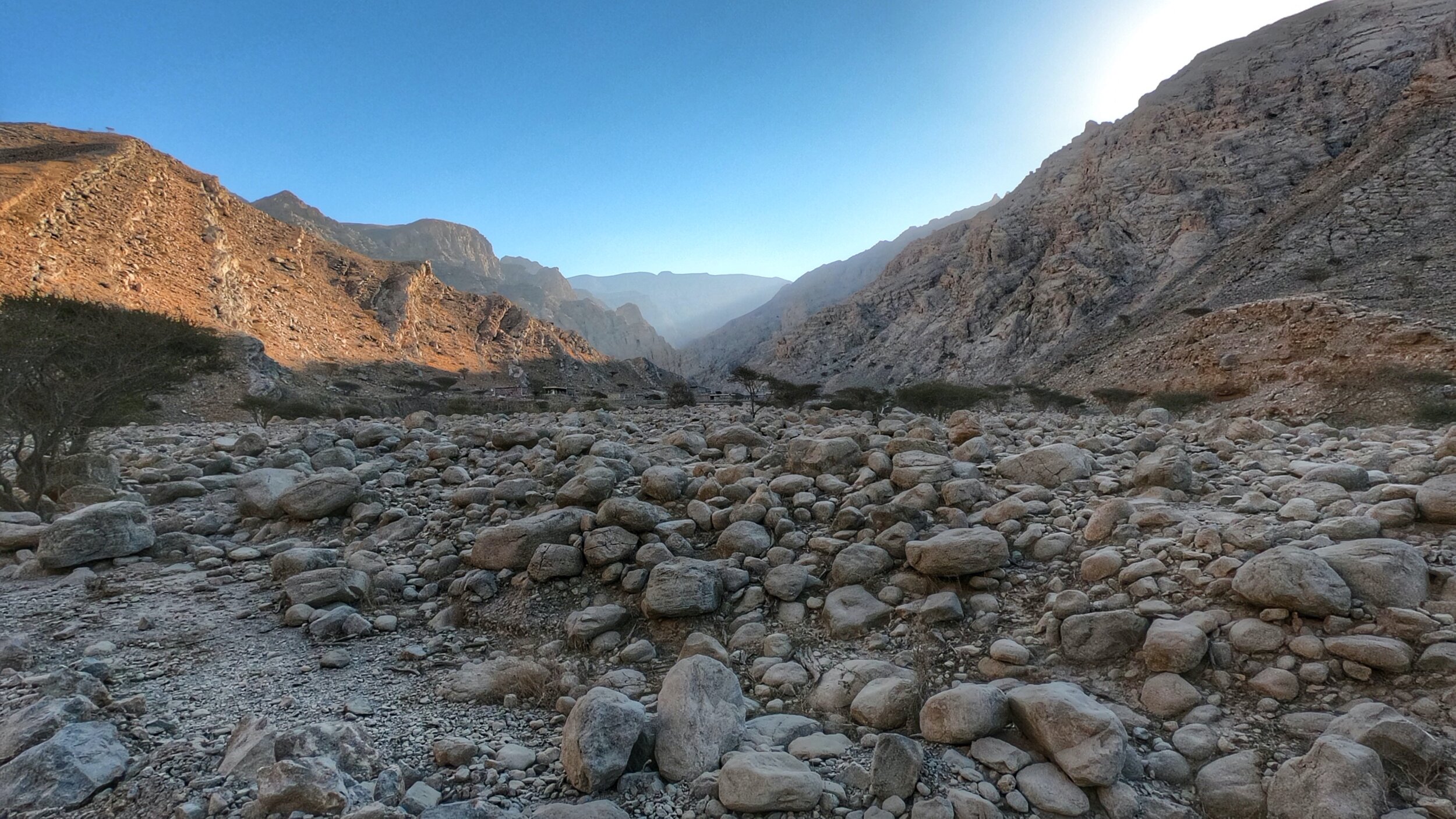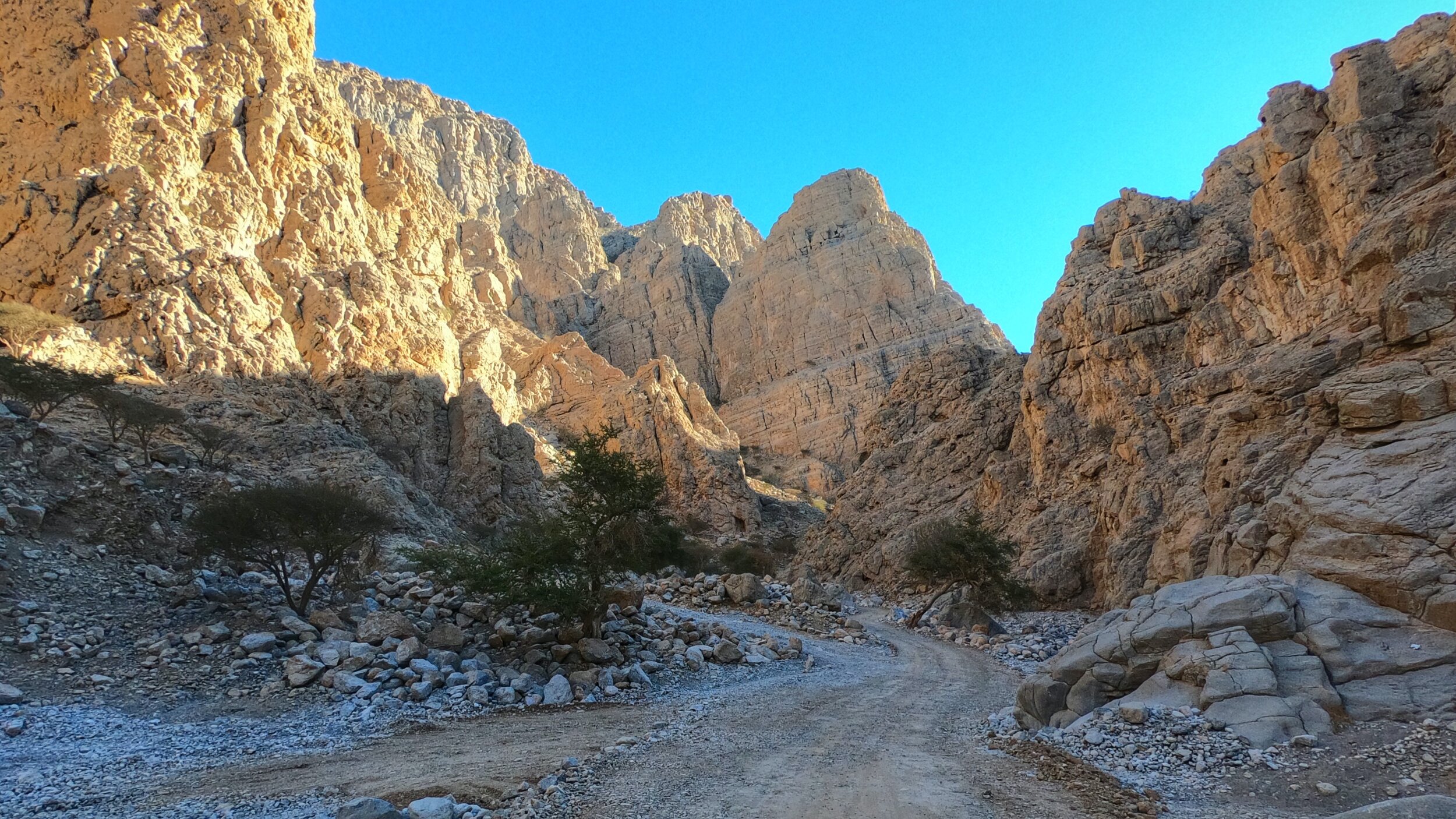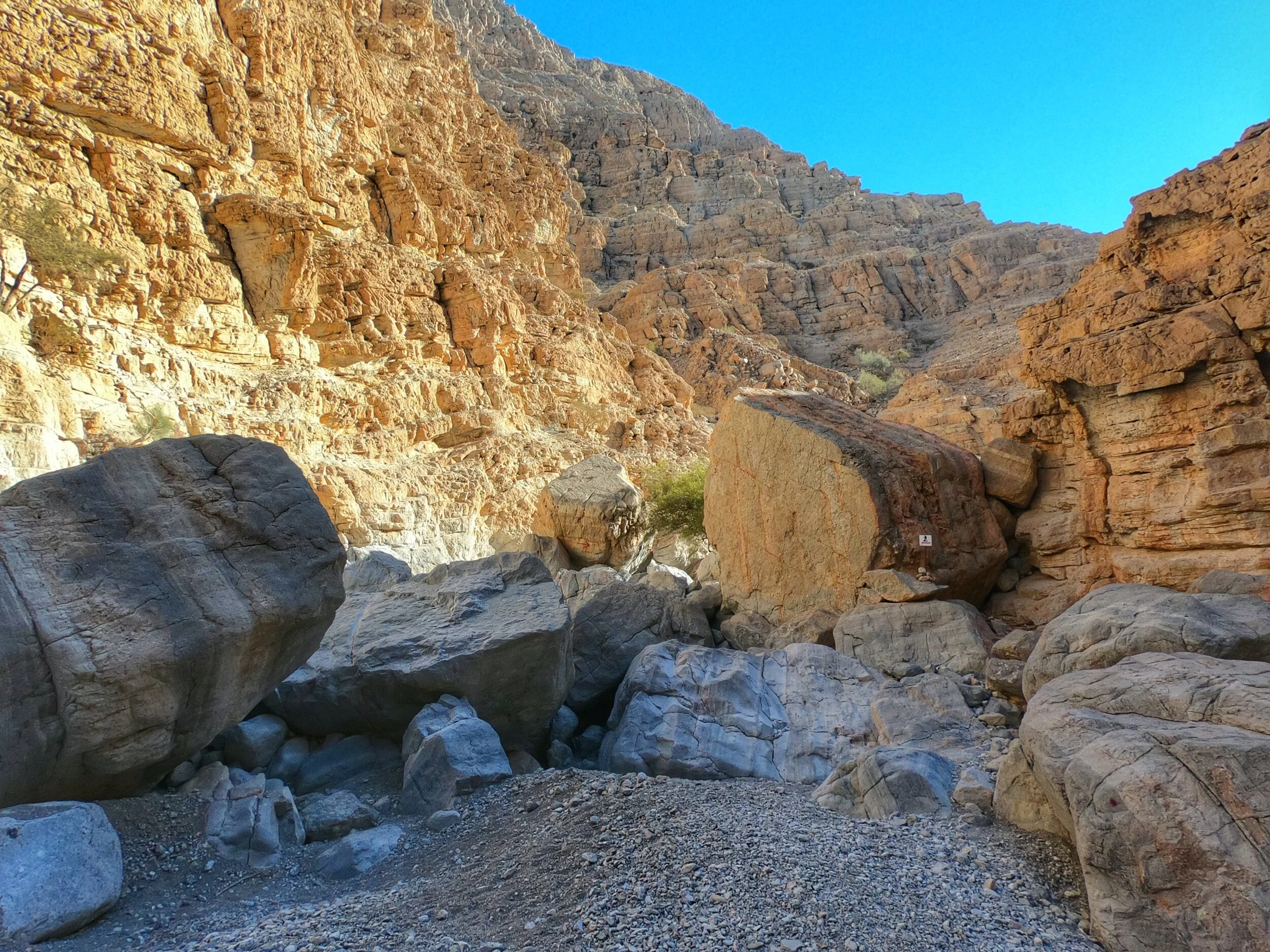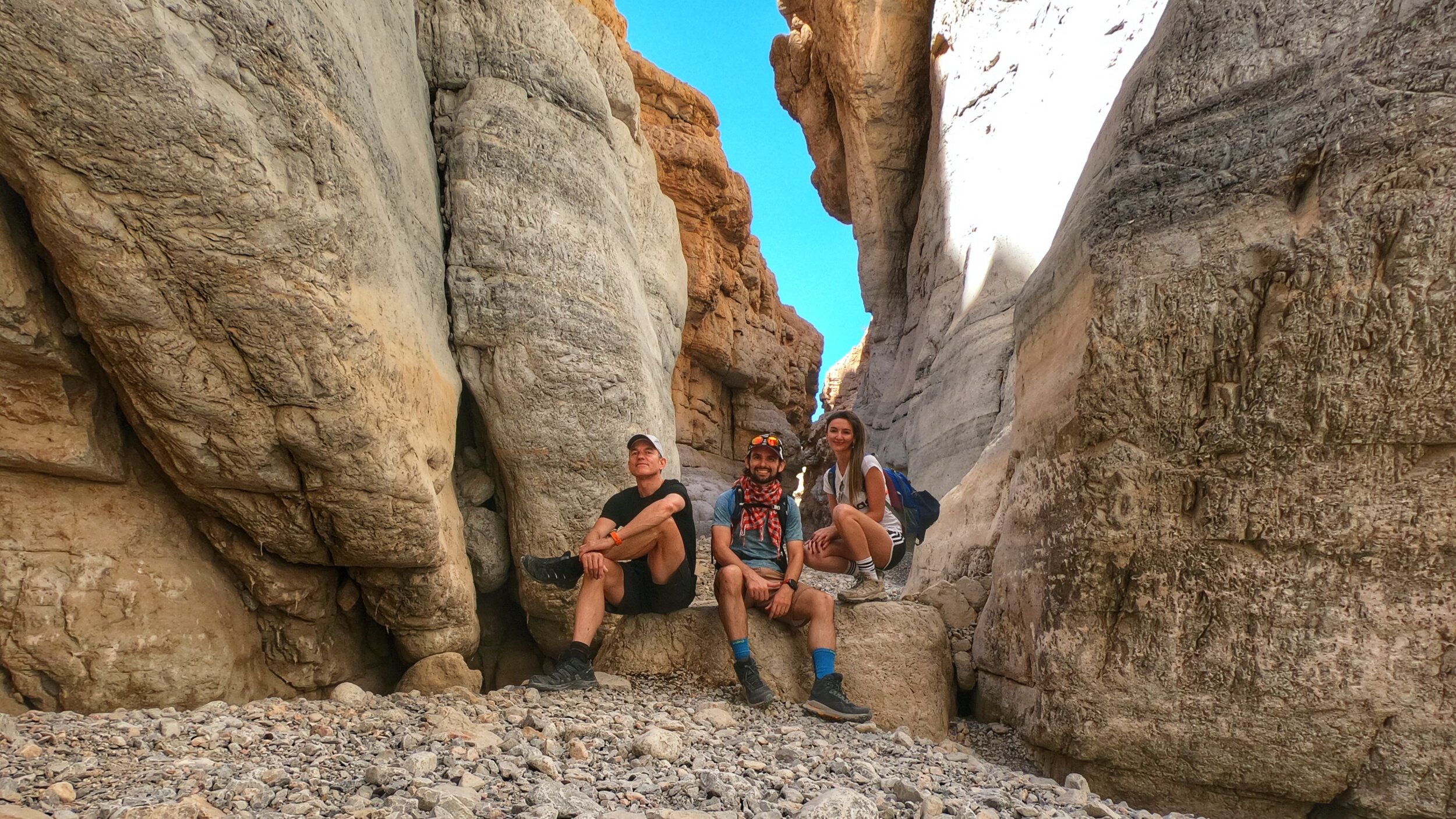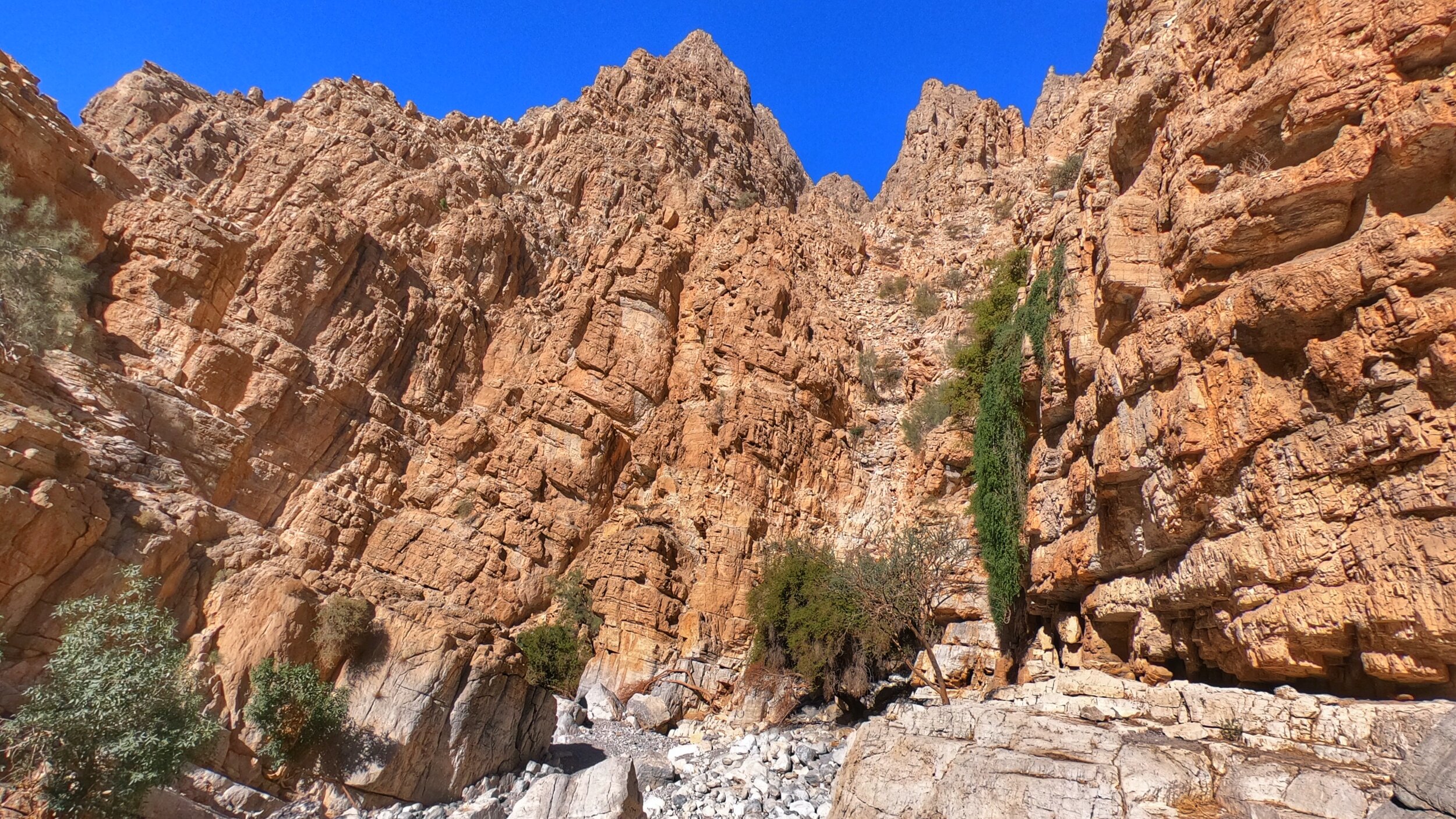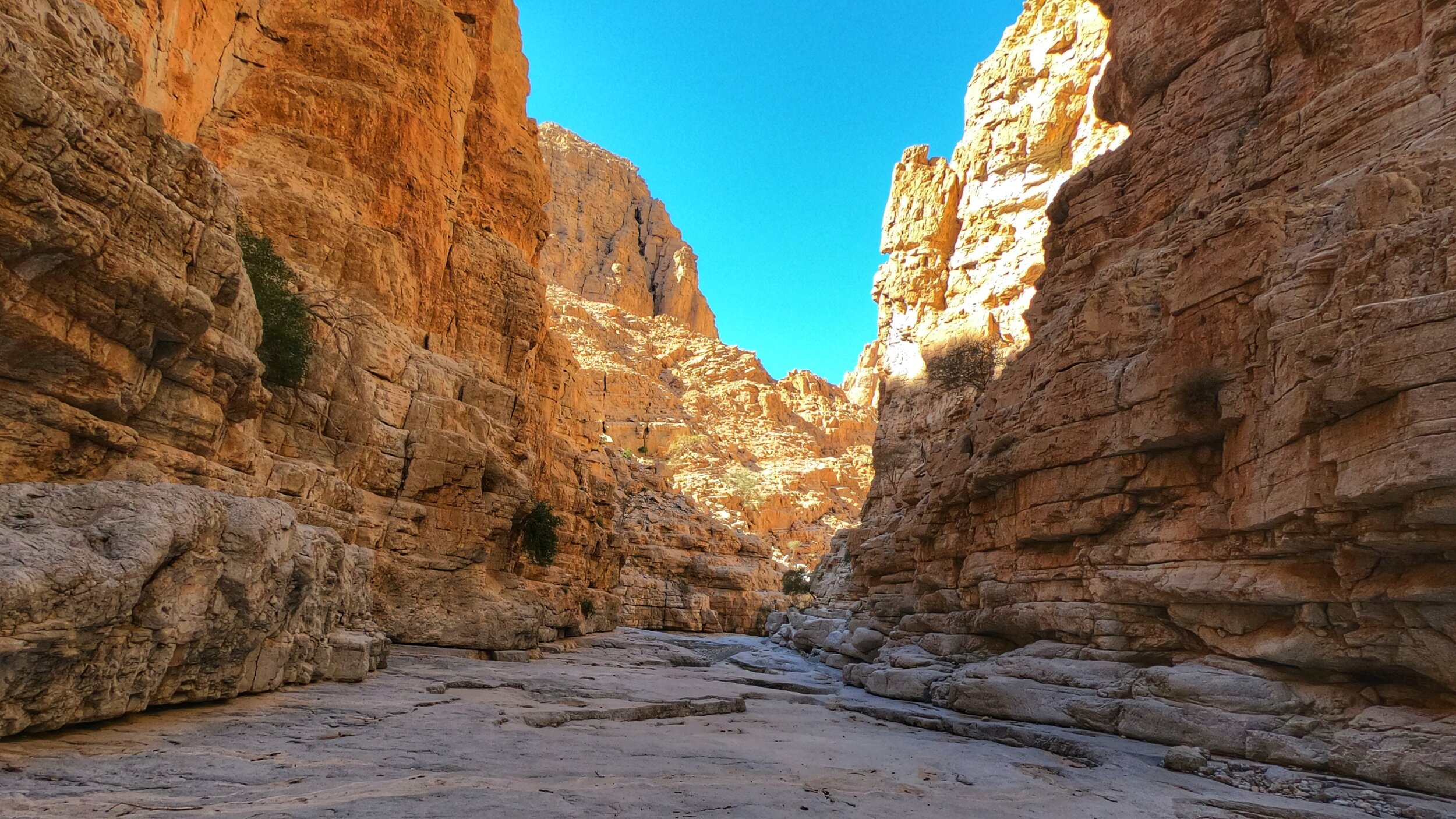Wadi Naqab & The Red Wall
Wadi Naqab, an area of the mountains to the east of Ras al Khaimah, is an area of outstanding natural beauty that a friend of mine had recommended visiting, especially since I'd started exploring more of the wonderful hikes that there are to be found in the United Arab Emirates. Located approximately 130km (1.5 hours drive) from Dubai, this seasonal watercourse channels down from the heights of the Hajar range, with rainwater pouring through a series of narrow, twisting gorges, via a plethora of plunge pools (dry most of the year), into the gradually widening wadi. The power and abrupt nature of the waters, when they do make an appearance, can be immense and I know several people, all with extensive experience of the mountains and wadis, who have been caught by surprise and had their cars claimed by flash flooding through this wadi. It is NOT an area to play in during wet and stormy weather as it's character can move from sublime paradise to hellish cruelty in an instant.
Thankfully the day I chose to visit there wasn't a single rain cloud in the sky - another classic UAE day of blue skies and pleasant (winter) temperatures. Essentially a perfect day to explore another of the country's beautiful wadis. With the fog hanging low over Dubai, the drive up north was a little slow in parts and as I turned off the main motorway and picked my way carefully through the hazy streets of small villages, the sun was not yet visible but still illuminating the scene. Then, just like that, I drove out of the fog and the mountains were there stretched out in front of me.
Given that I do not drive a 4WD (yet) I have to be a little more cautious when it comes to where and how far down unpaved roads I can venture. Keen to avoid too much additional walking either end of the hike I continued down towards the wadi until I reached a sign that very clearly stated that beyond that point it was just meant to be dam construction traffic. Taking that as my cue to park up, I found a suitably flat section of wadi to pull over onto & started preparing to head out, donning my boots and filling the Camel-Bak whilst waving to the drivers of the procession of construction trucks that were ferrying back and forth between the huge dam being built and wherever it was they were collecting their materials.
The dam currently under construction and apparently costing some $44 million to build was an impressive site, especially given it's size at over 250m in width and, apparently, 20m high. It will be interesting to return and see it full once it's finished and the waters arrive. Moving further along the wadi, which cuts into the Yanas mountain, the sounds eventually transitioned from the clanging of construction to the chirping of birds, buzzing of insects and the ever-present bleating of the ubiquitous goats that frequent every part of the mountains here. What I love about many of the wadis here is that the deeper you delve into them the more incredibly beautiful the landscapes become, with Wadi Naqab being no exception. The steep sided, multi-layered yellows, browns and reds of the moonscape rocks here point towards the fact that they were, once, part of a prehistoric seabed, a fact that I always find utterly humbling and that drives home how fleeting our time as humans has been on this planet.
The good thing, generally, about wadis is that there aren't usually too many points at which to get lost - you either walk in one way or you walk out the same way. However, at one point the wadi does indeed split in Wadi Naqab, with the right hand heading vaguely south through the mountains whilst the left fork heading on towards the Red Wall, an impressively sheer cliff face that gets it's name from the reddish colour that it adopts in certain light. So far, up until this point I had been the only person out in this part of the wadi, that I was aware of, although there was a car parked up a little along the right hand trail. A little way towards the Red Wall I was aware of a 4WD approaching from behind, which stopped to check on directions and offer me a lift. I confirmed that, as far as I was aware, based on the map data I had, we were all indeed on the right path to the Red Wall and politely turned down the lift, preferring instead to continue walking. I soon met up with the same car and ended up spending the rest of the day with Andre, from South Africa, and Rosa, from Italy, as we continued into the real hiking of the day, leaving the car under the watchful eyes of the goats.
After some initial bouldering and picking our way through the wadi, which was definitely becoming wilder in it's appearance, the trail tracked to the left and we began climbing, finding ourselves walking along exposed ledges with the wadi floor laid out below us. At no point did the trail feel unsafe, being easily wide enough and well trodden to satisfy even the most cautious hiker that they were in no real danger. Before too long we had a choice to make: climb up the slope of collapsed boulders to the right of the Red Wall and see where that path took us or continue round to the left, via a short, narrow ledge that had a metal rope anchored into the rocks to serve as a via-ferrata-style hand-rail, delving deeper into what was now becoming more of a canyon. We opted for this latter option, walking past a large UAE flag pinned to the cliff wall and entering what a sign told us was Wadi Koob.
There were, as before, photo opportunities abound, from the black rope scaling the smooth slopes of the dry waterfall, to the low ceilinged ledge along which we crawled in order to continue our exploration but that also appeared to be a particularly popular latrine for the goats. The canyon got narrower and narrower, whilst the sides became steeper and taller, the acoustics becoming more echoing and surreal. Before long, however, we arrived at a pool of water that whilst on initial inspection looked filthy, was actually very clear once the surface layer of dust and algae was disturbed. Any further progress would have required some ropes and a head for heights that none of us had that day and so we retraced our steps back to the car and the end of what had been yet another amazing hike and discovery of the natural wonder of this part of the UAE.
DISTANCE = 23km
TIME = approx 5 hours
Wild Swimming in Oman
Wild Swimming at its very Best
The very first time I’d had the pleasure of dipping my toes, closely followed by the rest of me, into a wadi pool was during an off-road group camping trip as a recent arrival to the UAE. Whilst I couldn’t for the life of me tell you exactly where those wadis were now - I was concentrating so hard on following the 4WD ahead of me that my sense of actual location was lost - I do remember the unique thrill of experiencing refreshingly cool, clean water in the stark barren moonscape of the crumbly mountains that run up the north-eastern edge of the Gulf Peninsula.
Whilst I have continued to do my fair share of outdoor swimming in the Middle East, it has pretty much consisted exclusively of sea swims since that initial wadi experience. It was with excitement then that I headed over to Oman during a week off work - the last one before the border was closed due to Covid - in order to spend some time exploring and playing in the Hajar mountains and wadis of the Sultanate.
My base for the few days of wadi exploring was a wonderful white-washed villa just outside the small town of Tiwi and idyllically situated on the edge of a wide pebble beach, with the expanse of the Gulf of Oman stretching off towards Iran in the distance and the setting for one of the most exquisite full-moon risings I have ever had the pleasure to witness. The moon rose from the inky black waters and climbed higher and higher, illuminating the gently rippling surface of the sea and silhouetting the scattered small fishing boats that acted to mark out the boundary between sky and sea. Beautiful.
Bimmah Sinkhole
After arriving mid afternoon at my B&B I quickly decided that there was still enough of the day left to warrant a quick trip back up the coast to check out Bimmah Sinkhole, which a colleague of mine had visited the month before and spoken highly of. Set back a very short distance from the main Sur highway and ensconced within the bounds of the Hawiyyat Najm park, a relatively small oasis of organised recreation juxtaposed with the wild, dishevelled coastline on which it sits, the sinkhole is approached by means of a short walk past manicured lawns, with the first sight being a wide, circular wall that arcs round to a narrow metal staircase leading down into the depths of the sinkhole itself.
Locals used to believe that the sinkhole resulted from a meteor strike, with the Arabic name Hawiyyat Najm translating as ‘the deep well of the (falling) star,’ although it is in fact a result of erosion by seawater of the relatively soft rock below the surface and eventual collapse of the original ‘roof’ creating the sinkhole that exists today. The waters of the Omani Gulf are no more than 600m away and it is these saline waters that feed into the sinkhole and into which I waded for the first of my wild swims of the trip.
With the sun starting its slow dip towards the horizon, casting large shadows onto the surface of the water in the sinkhole, which at about 70 metres by 50 metres is an impressive site, especially whilst descending the long narrow staircase to reach the rocky platform at the bottom, I tentatively slid down the slippery rocks into the cool still waters and sculled my way out to the very centre for a full panoramic view. The benefit of visiting mid week and towards the end of the day was that there were significantly fewer people present that there might have typically been, with, at most, three others also enjoying the waters.
In addition to being a unique swimming experience and visual treat, it was the quality of the sound that made a dip in Bimmah Sinkhole so memorable, from the cathedral-esque cavernous spacing of the centre, with the blue of an eternal sky immediately above to the reverberating echos and amplified sounds of splashes, laughter and one’s own quiet breath in the low ceilinged cave tucked off to the left like an aquatic chapel of tranquility.
Wadi Ash Shab
I’d have stayed up and enjoyed the incredible full moonscape longer had it not been for the fact that I wanted to get an early start to the next day in order to check out Wadi Ash Shab before the crowds arrived, which they were sure to. With a run and a decent brekkie under my belt I struck out for the very short stroll down to the small jetty from where launches, crewed by local Omanis, including my AirBNB host, Habib, ferry trekkers over to the far side of the lagoon and the start of the trail into the wadi itself. The fare? Just 1 Omani riyal for a return trip - easy! The trail started relatively wide, with small farm plots either side of the flat wadi floor, flanked by steep cliffs, growing a host of different crops including fruits such as bananas. About a kilometre and a half into the wadi, the first of the truly spectacular pools started and the trail climbed up the sides of the cliffs, carving a path, at times, literally through the rock, providing a heady but incredible view down into pools that whilst incredibly tempting to leap into, did not permit swimming.
The trail continued up and along the smooth rocky trail, polished over millennia by the actions of water flowing down the valley, eventually crossing over a stream, winding past more small plots organised in terraces that appear to be layered one on top of the other, before taking a sharp left turn into a part of the wadi that could have been lifted straight from the pages of a story about a long-lost civilisation. The light at the time was perfect, with the sun illuminating in golden hues a vista of sandy yellows, aqua marines and rich, tropical greens. This was the part of the wadi that truly represented what it was I, and all of the visitors to this part of Oman, had come for: Mother Nature’s waterpark.
It wasn’t initially clear where the climbing and trekking was meant to cease and the wading and swimming started as I found myself skirting along the steadily climbing and increasingly precarious cliffs, with the water below. Eventually my gut instinct convinced me that the path I was on was not correct and so I backtracked to the start of the watery channel and decided that I might as well press on through the water itself. Having changed into a pair of dive boots - I’d heard that having something on your feet was advisable for sections of the wadi, especially the narrow pebble-filled channel that linked two pools at some point along the course and over which one had to walk. It did also make climbing the often very slippery rocks that much easier thanks to the additional friction the boots’ rubber soles provided.
With my shoes, clothes and valuables all firmly ensconced within the dry bag I’d trekked in with, the latter being further protected inside an additional, smaller dry bag - yes, I can be a bit of a pessimist and prefer to plan for the worst - I started wading into the water, gradually sinking deeper and deeper until I was able to start swimming along. The scene was wondrous! The water so clean and clear that it was almost completely translucent and refreshingly cool, not cold. I truly felt as though I was an intrepid explorer striking out into uncharted, potentially dangerous yet intriguing territory and I couldn’t help but swim along with a grin from ear to ear. It was shortly after I set off that I got a foreboding sense that my dry bag wasn’t as buoyant as I had expected. I’d used the same bag on a previous swim adventure when I found myself drifting down river in Berne, Switzerland two years before, and yet this time the bag seemed to be sitting lower in the water than usual. Time to investigate.
On a corner, as the first long, winding wadi pool came to an end and fed into the aforementioned pebble-floored channel, I climbed out onto dry land and opened up the bag. It turned out that my ‘dry’ bag was, unfortunately, anything but, the insides now being very much that of a soggy bag. My shoes, towel and clothes were all sopping wet although thanks to my ‘prepare for the worst’ approach to the valuable and electronic items, they were all safely still bone-dry. Phew! My original plan had been to just swim and explore the wadi with my belongings in tow the entire time but this spanner in the works meant plans had to change. Certainly not intending to turn back and abandon my explorations I threw caution to the wind and stashed my bag as safely out of sight as I could behind a rock, praying that this wasn’t prime thieving territory and that the rest of the day trippers out were honest types who would politely ignore that which wasn’t theirs. That trust, thankfully, was well placed as no matter how well I tried to hide it, the bag was bright red and not really that well hidden yet remained undisturbed until I returned to it a couple of hours later. It might have actually been a blessing as liberated from the bulk of a bag I was able to climb, scamper and swim through the wadi with so much more freedom than I’d have been afforded otherwise. Sometimes shit happens and it ends up being for the best.
I would describe Wadi Ash Shab as being divided, broadly speaking, into three, maybe four, distinct sections. The first is the section of water that had brought me to the rocky landing where I left my bag and that sees the wadi transition from wide oasis to narrow, steep walled water-filled channel. Then comes the section that whilst still submerged is only under a few inches of water and is characterised by a narrow, flat yet stony path that weaves through a small patch of reeds and assorted foliage, obscuring what sits beyond. The wadi then opens up again into a number of interconnected swimmable pools, with sections deep enough to safely jump into from the rocks, before terminating at a split in the rock face. For those not confident in their swimming abilities this is probably the place to call it a day. I feel comfortable in water however and wanted to check out the jewel in Wadi Ash Shab’s crown.
Pushing onwards and between the low-slung, incredibly narrow split in the rock that at times was barely the width of my head, the scene opened up to reveal the inside of a cave, illuminated by natural light from gaps in the roof and a waterfall cascading down into a plunge pool, from a narrow rocky channel that disappeared up into the eaves. This was soooooo much cooler than I’d expected it to be! There is nothing that humans can build that will ever surpass the splendid, pure, raw beauty of natural landscapes such as these. Mother Nature, geology and time are the ultimate architects and contractors all rolled into one and I was inside one of their bespoke mini-cathedrals.
Roughly 10 by about 12 metres with a floor that is a lot deeper than I am tall, this part of the wadi was just pure joy to explore and take in. Whilst the centrepiece is most certainly the waterfall, there is a narrow, navigable channel carved out from the rock that takes explorers directly behind the falls, starting from a gap so narrow that you’d be forgiven for missing it - I almost did were it not for an excited Dutch tourist gesturing me towards it like a ten year old who had just discovered the world’s greatest hideout and wanted, or needed, to tell someone, anyone, about it - and, after a short, dark traverse opens back into the main cavern, emerging from the opposite side of the falls.
Someone had anchored a rope into the rock with the end of it hanging invitingly down the left hand side of the waterfall. Not needing much encouragement I hauled myself up the rope and the slippery rocky channel and paused at the top not entirely certain of where to go from there other than back down into the water. A trio of French visitors then did the same except instead of stopping at the top of the rope they pressed on further up the rocky chute down which the water was tumbling and out of sight. With the validation that it wasn’t an insanely daft idea I swum straight back over to the rope and followed in their footsteps. The reward was to emerge into the open, by means of a small hole in the rock, into an entirely different section of the wadi, this one elevated from the pool itself and home to yet another deep pool of water. This pool was framed by steep sandy rocky cliffs and fringed with plants gently swaying in the gentlest of breezes that sent tiny ripples across the surface of the water, adding to those produced by dragonflies sporadically skipping across the pool. I did wonder what other gems there might be to discover further up and along the wadi but thoughts of further exploration were quelled by the fact that I still wanted to try and get to Wadi Tiwi before the end of the day and as such it was probably about time to retrace my steps and leave what was, at the time, one of my new favourite places on the planet.
It turned out to be a good time to call it a day as the crowds were most certainly beginning to arrive en-mass. As I exited the water-filled cave, returning to the open air swimming of the main wadi, I found myself wading counter to a steady stream of tourists and by the time I returned to my starting point at the mouth of the wadi the scene had transformed into one resembling a beach on a weekend, with sunbathers galore. I’d definitely made a good decision by heading into the wadi nice and early.
Wadi Tiwi
The best thing about getting an early start to the day is that there’s time to pack in more than you would ordinarily get around to doing. With one wadi visit ticked off I found myself with the enviable option of getting in another, one that hadn’t even been on my radar originally. Wadi Tiwi sits at the end and upper reaches of a large wadi that starts in the town of Tiwi and travels for about ten kilometres inland, climbing through villages and traversing increasingly steep and remote track until the road comes to a halt. Having read warnings online about needing a 4WD to make the drive and recognising the fact that my hire car was in actual fact a ‘pretend 4WD’ I asked Habib whether he knew of anyone I could pay to take me up to the wadi. He clearly had much greater faith in both my car and my driving abilities than I did as he dismissed the warnings and reassured me that I would be absolutely fine to drive myself. Well, I figured, if he thinks so then how bad can the drive really be? And so I set out to discover for myself.
The answer was ‘bad.’ My car was A-ok for the first 4km, as the wadi started to ascend through the first village, only having to contend with the incredibly narrow road and blind corners. Things, however, got interesting as I came to the final corner and short stretch of tarmac exiting the village, where I had to pause to let a few cars down. As I moved to pull off up the hill, cognisant of the fact I now had a short queue of traffic behind me, I felt my wheels spin and the smell of burning rubber fill my car. “Uh oh!” I thought. “That ain’t good!” Long story short I was not going to get myself up that hill and had already decided that they best thing to do was turn around (somehow) and head back down again. The guys in the car behind me, however, thought differently. They were confident that the car could get up and so one of them hopped in and somehow screeched the thing up the hill, narrowly missing a brick wall in the process, before handing back control to a slightly shaken me. It was more politeness than anything that saw me cautiously continue to follow the road further on up the wadi as I didn’t want them to see me turn the car around and undo their work. If that was a taste of what lay ahead further up the wadi then I knew full well that the online reports were correct: this was 4WD territory. And so having spotted a bit of a lay-by at the top of the next alarmingly steep section of hill, I swung the car in and looked at the option of pressing on ahead by foot.
There was, however, no need to walk - a good thing too as it was a loooong, steep climb - as there was a regular stream of young local villagers zipping up and down the road in battered 4WD’s, ferrying tourists. After negotiating a price with one guy who was en route back down with a Dutch couple and waiting for him to return, I was once again on my way and quickly realised how sensible it had been to abandon the self-drive option. The road just got progressively more extreme: narrow, rocky and steep. My hire car was NEVER going to get up to the final village, Mibam. Never ever. The views, however, were breathtaking. At one point we emerged from the lush foliage of a small village, climbing up over a pass that afforded vertiginous views up and down the wadi - incredible! Eventually we pulled up in front of a small house and I was gestured to follow my guide, a young guy by the name of Mohammed, as we trekked down the hill, through various small farm plots of fruit trees and date palms, terraced with criss-crossing water channels providing irrigation.
After about ten minutes of descent we emerged onto a flat area of rock, fringed on both sides by lush green vegetation. This was the start of the wadi itself and it quickly became apparent that this place was indeed incredible. The first sight of the water was a series of brilliant azure pools, fed by a cascading waterfall, the top of which we were standing upon. Mohammed lead the way down the steep sides of the sandstone towards the water and indicated that this was a great place to leave my stuff in order to then press on to explore the wadi. I confess that I was a tad apprehensive about the idea of leaving my belongings again, especially given that there were a lot more people around, and spent what was clearly an obviously long amount of time securing the clip on my bag as best I could - not to prevent someone going into it but that would have made it obvious if someone had, a fact that I hoped would simply serve to discourage anyone from being tempted. In hindsight I was being unnecessarily untrusting as my bag was left completely undisturbed the entire time Mohammed and I were exploring the lower reaches of the wadi. It would appear that there are indeed some parts of the world where basic principles of decency still widely exist.
Any apprehension I might have been feeling about leaving my belongings unattended evaporated as we eventually hit the water itself and I found myself utterly enchanted by this fantasyland vision of paradise. If Wadi Ash Shab felt like a slice of natural wonder, this place was straight up idyllic. I felt like I was in the film Avatar except with aspects of one of those exotic shampoo commercials thrown in for good measure. Each successive stretch of water became more and more picturesque and exotic, with a plethora of dragonflies of differing colours the likes of which I don’t think I have ever seen anywhere else. The water was, as in Wadi Ash Shab, clean, refreshingly cool and clear, and calm, with just the gentlest of flow as the water inched its way down the wadi towards the sea. Each successive body of water that we traversed seemed to have it’s own distinct character, with some flowing beneath giant overhangs of rock, whilst others ran smoothly through narrow curves in the cliffs, before arriving at the piece de la resistance and a scene worthy of poetry. Just imagine the most tropical jungle pool you can. That’s what I was now looking at and then swimming in. At least 25 metres by 30 metres and flanked on two sides by vertiginous cliffs down which creepers and vines cascaded, stroking the surface of the water and adding the exotic drip, drip, drip of water drops tinkling into the pool below, I could have happily remained in this exact spot for the rest of the day. Mesmerised by yet more dazzlingly large and metallic-hued dragonflies of myriad colours, basking on sun-kissed rocks and skipping over the water’s surface, the waters continued their journey sea-ward, dribbling over one edge of the pool on a quest to find the next of what I am sure was many more equally stunning pools lower down the wadi.
It was, however, at this point that Mohammed gestured me back and as he took the more direct, drier, rock-based route back to the start, I retraced my paddling steps back through the wadi waters, finally scaling the huge boulder at the start, aided by a long rope fed down to me by Mohammed. A truly mesmeric experience and a genuine oasis of peaceful tranquility, I was so incredibly pleased that I had followed my own sense of curiosity and persisted in making it to this place. It was worth the effort and some.
A successful two days of wadi exploring and three memorable wild swims to look back on fondly.



